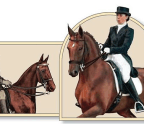OLD SORREL AND BEYOND

In writing the history of the Quarter Horse in EQUUS over the past two years, I have revisited many old-time Texas breeders and big spreads, such as the Waggoner Ranch and the 6666, known for producing superior all-around ranch horses and arena competitors. Yet for all the contributions made by others, the Quarter Horse as we know it today would not exist had it not been for the breeding program initiated in the early 1920s by Robert Kleberg, Jr., of the King Ranch.
The largest ranch in America, the King operation comprises a vast empire of oil-rich, arable plowland and managed pasture stretching over 825,000 acres in South Texas. Kleberg was one of the first scientific horse and cattle breeders, and he and the King Ranch are credited with creating during the 1940s not only an entirely new breed of cattle―the Santa Gertrudis― but the Sorrel strain of the Quarter Horse (see “The Rise of an Empire,” EQUUS 499, and “Great Horses by Design” EQUUS 500).
This article concludes our history of the King Ranch and marks the finale of the exploration of Quarter Horse history that we started in 2014. To mark this milestone, I will take advantage of a rare opportunity. It is rare because, thanks to Kleberg’s desire to educate other breeders and promote the new breed, during the 1930s and 1940s good conformation photographs were taken of the King Ranch foundation sire Old Sorrel as well as nine of his sons. Old Sorrel sired about 30 sons all told and photos were taken of most of them, but because most were taken from the front or rear they are not useful for quantitative conformation analysis.
We can also analyze Peter McCue, widely influential in the Quarter Horse breed and Old Sorrel’s grandsire. In addition, we can look at the broodmare Water Lilly and the best King Ranch “outcross” Quarter Horse, Little Joe. By the fabulous Traveler and bred by Dow and Wil Shely of Alfred, Texas, Little Joe’s daughters proved to cross very well with Old Sorrel sons (portraits of other King Ranch broodmares and of Little Joe appeared in our last installment).
So widespread has been the influence of Old Sorrel and his get that chances are your Quarter Horse descends from him in at least one line. Even if Quarter Horses are not your thing, the breeding technique used by Kleberg is worthy of study. The many analyses presented in this article are a valuable tool for sharpening your “eye” for skeletal structure on the inside and bodily proportions on the outside. Measurements, portraits and comparisons presented in this article allow you to see the family resemblance in the sons and grandsons of Old Sorrel. They also make very clear how the King Ranch moved the Quarter Horse type away from long-bodied racehorses with a “downhill” body balance (red line in conformation analysis drawings) to horses with more compact, level conformation ideally suited to ranch work and arena performance.
You’re reading a preview, subscribe to read more.
Start your free 30 days





